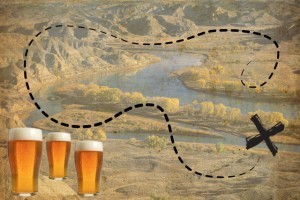Matador Network's Blog, page 2268
May 21, 2014
10 types of 30-year-old single guys
30-YEAR-OLD GUYS ARE A CURIOUS BUNCH. Find me a group of 30-year-old men and I’ll pick out one overgrown frat dude living with roommates, another guy who just dropped his two kids off at school, a few who are well into their careers, and a couple soul-searchers looking for work. Some will tell you they’ve finally figured it all out, and some will say they feel hopeless for the first time in their lives.
It’s a motley crew. But perhaps the motliest part of this crowd is the ever-growing group of 30-year-old single guys. If you want a case study in humanity, 30-year-old single guys have pretty much all the bases covered. Let’s examine some of the common types.
1. The Total Package
The Total Package is smart — he went to a top college. The Total Package is an athlete, a musician, and an avid traveler. The Total Package is handsome — and you better believe he’s well-groomed. The Total Package has a hell of a career going, but don’t you for a second suggest that the Total Package would be a workaholic — the Total Package is a family man.
There’s just one thing the Total Package seems to be having a hard time finding — a girl worthy of his greatness.
Yes, the woman fit for the Total Package will be the ultimate icing on his cake of perfection. He imagines her often — gorgeous as they come, she turns heads; bursting with charm and charisma, she lights up every room she enters; she’s a brilliant rising star in her career and beloved by her many friends. And that’s just her public persona — at home, she’s fantastic in bed, a spectacular cook, loving, selfless, and devoted. Oh, and she also speaks French, plays tennis, sings beautifully, reads voraciously, and she’s a history buff. His Juliet.
Unsurprisingly, the Total Package is single. He’s immersed in a fierce battle between his superhuman standards and his terror of being 40 and single — because 40 and single is not supposed to be part of the Total Package’s story.
2. The New Lease on Life Guy
As long as anyone can remember, the New Lease on Life Guy had been dating his long-term girlfriend. He never seemed that happy in the relationship, but everyone just assumed they would eventually get married. Now, after a long and difficult breakup, the New Lease on Life Guy has reemerged with a bang and is suddenly acting like he just got called down on The Price Is Right. He’s not really sure how to be single, but he’s goddamn happy he is, and he’s sure as hell going out tonight.
He’s also the arch-nemesis of the Resigned Fiancé, who’s in an equally unhappy relationship but just kind of kept going with it, unable to resist the sweet, sweet inertia, and who most certainly does not want to hear about the New Lease on Life Guy’s latest exploits.
3. The Guy Who Has to Marry Someone of the Same Ethnicity or His Parents Will Never Speak to Him Again
It’s hard enough finding someone to be your life partner, and this guy’s parents are really not making things any easier. He tried to rebel briefly, but after his last girlfriend was not allowed in his parents’ house, causing her to cry, he gave up on that.

More like this: The 7 types of modern American bigots
He’d also really appreciate it if his mother would stop setting him up on dates.
4. The Misogynist
The Misogynist hates women, and women hate the Misogynist. The Misogynist doesn’t know a whole lot about the other gender, but he can tell you the exact number of them he’s slept with — 214.
He did quite well with girls back in his earlier days, when many were in their ‘attracted to assholes’ phase, but lately only those with the lowest self-esteem seem to gravitate toward him.
The Misogynist’s close cousin is the Perpetual Cheater. They’re different but they understand each other.
5. The Guy Who Peaked Too Early
Back in the day, the Guy Who Peaked Too Early had everything a 17-year-old girl could ever dream of. His sky-high confidence carried him smoothly through college, and no one was surprised when he landed a smart, sweet, beautiful girlfriend in his early 20s. But the Guy Who Peaked Too Early was just getting started. There was a field that needed to be played, and he broke up with his girlfriend when he was 24.
Now it’s seven years later, his hair got bored and left, and his high school football glory isn’t part of the conversation that much these days. And he’s noticing that girls like his ex-girlfriend don’t seem to be all that into him anymore. Realizing this about five years after everyone else, he takes a deep sigh and cranks his standards down a few big notches.
His antithesis is the Guy Who’s Finally a Good Catch. After losing some weight, getting decent clothes, and having early career success, this guy is getting more attention each week than he got in his first 25 years combined. He prominently displays photos on Facebook of himself on dates with attractive girls for the express purpose of making sure everyone from his high school sees his current situation.
6. The Normal Guy Who Just Hasn’t Met the Right Girl Yet and Really Wishes People Would Stop Looking at Him With Those Pitying Eyes
Ah, The NGWJHMTRGYARWPWSLAHWTPE. The NGWJHMTRGYARWPWSLAHWTPE is enjoying his life. He likes his job, he likes his friends, and he likes being single just fine. He’s in no rush to be in a relationship and feels totally confident that at some point, he’ll meet the right girl and get married.
He’s also not quite sure why everyone who knows him is trying to figure out “what the problem is.” His parents are worried, never wasting an opportunity to ask him if he’s been dating anyone. His friends want to help, setting him up on dates every chance they get. He appreciates all the unsolicited support, but he also thinks it would be pretty great if everyone stopped thinking there was something wrong with him.
7. The Aggressively Online Dating Guy Who Can’t Believe He’s Not Married Yet
The opposite of the previous guy, the Aggressively Online Dating Guy Who Can’t Believe He’s Not Married Yet can’t believe he’s not married yet. Through high school, college, and his 20s, he was always the Guy With a Girlfriend. He spent years enjoying pitying his single friends, and somehow, he’s now 30 and single.
He has four online dating profiles, and when people ask him if he’s dating anyone, he explains that he’s just too busy with his career right now for a relationship.
8. The In-the-Closet Guy
The In-the-Closet Guy is so close to being the perfect catch — he’s handsome, he’s well-dressed, and he has a great job. He’s funny, articulate, and charming. The only tiny little inconvenience is that he’s not attracted to females whatsoever.
His antithesis is The NGWJHMTRGYARWPWSLAHWTPE, who’s had just enough of the theories about him being gay, since he’s completely straight and, for the hundredth time, just hasn’t met the right girl yet and is really very okay with being single right now.
9. The Chinese Single Guy
The Chinese Single Guy appreciates the government’s effort to control population through their One-Child Policy. He really does. But he’d also, ya know, like to lose his virginity at some point, and that’s kind of hard when there are 18% more men than women in his generation. This is because a lot of the Chinese Single Guy’s potential girlfriends were killed by their parents when they were two hours old.
The Chinese Single Guy doesn’t know what China’s plan is for the excess 18% of guys who will not be able to find a wife, but he’s pretty sure they’re not making the situation any easier by rampantly discriminating against homosexuality.
10. The Guy Who Has Just Fully Quit at This Point
The Guy Who Has Just Fully Quit at This Point never tried that hard in the first place, but at least there used to be a semblance of effort. He doesn’t like going to bars, refuses to try online dating, and both the bong and the X-Box are back in the living room following their brief stint in the closet after his friend gave him a pep talk one day four months ago.
Deep down, the Guy Who Has Just Fully Quit at This Point is pretty frightened about a lot of things, but his fear manifests itself in indifferent denial, and passivity usually prevails. There’s only way that things change for the Guy Who Has Just Fully Quit at This Point, and that’s to find himself squarely in the sights of the Girl Who Relentlessly Pursues. Until then, the whole thing isn’t really his issue. 
This post was originally published at Wait but Why and is reprinted here with permission. Wait But Why posts every Tuesday. To receive Wait But Why posts via email, click here. Or you can visit their homepage, pop into Facebook, or connect via Twitter.
The post 10 types of 30-year-old single guys appeared first on Matador Network.

My mother as wingman in Greece

Photo: Clapagare
“Oh no you don’t,” my mother said. “You’re not going to jump off from there.”
“It’s deep enough,” I said, teetering on the edge of the schooner, the Aegean Sea below. In the distance, the white-washed buildings clinging to the edge of the caldera looked like snow.
“I forbid it!” she said.
“Mom, I’m 35.”
“Then act like it,” my mother called.
I leapt into the sea.
As I climbed the ladder back into the boat, the sandy-haired stranger smiled at me and winked. I had noticed him as soon as we had boarded the sunset cruise. He had smiled at me then, and being my mother’s daughter, I smiled back. He didn’t look like the usual tourist — sunburned, tennis-shoe-clad, a face tinged with an expression of awe and indigestion.
“What do you think you are, a mermaid?” my mother asked.
“Maybe,” I said and smiled over to the sandy-haired stranger.
My mother caught me and said, “What are you looking at?” even though she already knew.
After a hiking trip up Nea Kameni volcano and a swim in the cloudy warm springs, the tourists were settled back in the boat, drinks in hand, and the sandy-haired man played the saxophone, serenading the setting sun. My mother and I sipped Greek wine, listened to the breathy saxophone, a sound both sassy and serious. The music of a clandestine love affair. Or so I imagined.
It was my mother who’d asked him to ride up the rickety cable car back to Fira with us, who’d invited him to dinner. It was as if she wanted to make sure somebody was going to have a Shirley Valentine experience in Greece.
But this proved to be quite an ordeal, considering Benny, the Albanian saxophone player, had a repertoire of about 10 English words. He could speak Greek, Italian, and of course, Albanian. I can speak Spanish, a language closer to Italian than English, so we managed on Benny’s Italian and my broken Spanish, understanding about 7% of what the other said. We made it through dinner this way, eating takeout gyros on a park bench. He invited us to have drinks later at Enigma, the nightclub where he worked.
“That Benny sure is nice, isn’t he?” my mother asked.
“I guess so. It’s hard to talk to him.”
“He’s handsome.”
“Did you see he’s missing teeth. In the back?” I asked.
“Don’t be so judgmental,” my mother said.
We wandered the cobbled streets, past the tourist shops and bougainvillea, and then had a drink at an Irish pub called Murphy’s. When we thought it late enough, we headed for Enigma.
The bouncer told us that we were too early. It was 10pm but things wouldn’t get started until midnight. Or later.
“Can we just come in for a drink?” my mother asked. “We know Benny.”
So we entered through the neon-lit cave that looked like the tunnel where you wait in line for Disneyland’s Space Mountain. The curved ceilings hung low, the purple neon glowing on the white cave walls.
We were the only patrons in the club.
“It smells like urine,” my mother whispered. “Why did you bring me in the back alleys?”
We walked up to the bar, and ordered white wine, which tasted like vinegar. I asked the bartender how long the bottle had been open, and he just gave me a blank look. My mother told him, “We’re friends with Benny, you know.”
I knew I couldn’t have been the first woman to come in looking for Benny after the boat ride. But I may have been the first woman who had come to the bar accompanied by her mother as wingman.
At the beginning of our trip, my mother had announced that she was no longer going to be passive aggressive. “I’m giving it up,” she had said. In her very next sentence, she asked if my ex-husband, who I was living with again, had ever bought me an engagement ring.
“You know the answer,” I said.
“Do I?” she asked, all innocence. For my mother, different truths exist in different rooms of the brain. At any given time, she decided which room to live in, whether or not secrets and lies decorated the walls. I’d learned to go along with it, depending on the fixtures that told me everything was okay; all of it, normal.
So it didn’t seem anything but normal when my mother and I danced with Benny on the empty dance floor, the bartender looking on with an amused smile. Or when Benny started calling my mother “Mama,” which she tried, unsuccessfully, to discourage because she thought it made her sound old enough to actually be his mother, which of course she was.
When we went back to the white leather couches, Benny squeezed in next to me. He went in for the kiss, and I gave him my cheek.
“Want to see the rooftop terrace?” Benny asked in Italian. The word terrace is the same in Spanish, so I translated for my mother.
“You two go ahead,” my mother said, waving toward the door. “I’ll stay here.” She took a sip of her vinegar wine.
“Thanks, Mama,” Benny said.
I followed Benny up to the rooftop terrace. The lights of Santorini glimmered on the purple Aegean Sea. I breathed in the sea air, and Benny tried to kiss me again. I squirmed away, not because of modesty or because of my live-in ex-husband. In truth, I liked Benny more from afar; the saxophone’s allure was not in the fulfillment of an affair but in its promise.
“I want to kiss you,” he said. These were among his ten English words, and he didn’t really need them because the way he tried to press his mouth to mine made his intent obvious enough.
“We haven’t even had a date,” I tried, as if that had ever stopped me from making out with a stranger.
“But I love you,” he said, trying to kiss me.
“You don’t love me. You want to fuck me.”
“Yes. I want to make fuck but also I love you.”
“Uh-huh.”
“You are beautiful, and I want to make fuck.”
“I’m sure you do.” For every backward step I took, Benny took one forward. Our bodies cast dark shadows in the yellow spray of a nearby streetlamp; we stood at the edge of the terrace against a stone wall, the sea shimmering far below.
He nodded and twisted his face into what could pass for sincere.
“That’s fine,” I said, “but I don’t want to leave my mom for too long. We should go back.”
When he looked at me, confused, I said, “Mama,” and pointed down to the club.
He nodded and said in Italian, “We will have a date tomorrow. I will pick you up on my moto. We will go to the beach.”
“Where?” I asked, catching all of it but the last part because the Spanish and Italian words for beach are nothing alike.
“To the sea,” he said in English.
“What time?” I asked in Spanish.
“Dieci,” he said.
“Diez?” I held up all of my fingers, and Benny nodded. I told Benny the name of the hotel where we were staying. It was one of those third-drink decisions. And I reasoned that most of us just want to make fuck; at least Benny had been up-front about it. Sometimes the fewer words we are able to exchange with each other, the more honest we become.
I lived inside a story I hadn’t yet heard but had somehow always known.
Benny smiled and said, “Back to work now.”
When I got back down to the club, my mother had just ordered another glass of wine.
“Let’s go,” I said.
“But I just ordered another drink.”
“It’s like vinegar.”
“It cost me good money.”
“Bring it with you.”
“How can I?”
I took the glass and put it inside my jean jacket. “This is how. Let’s go.”
“Suzanne!”
“This way it won’t be wasted. We can give the glass to Benny tomorrow.”
“Tomorrow?”
“I sort of made a date with him.”
My mother and I ended up getting lost on the way back to the hotel, and my mother said, “Why are you leading me through the back alleys of Greece?”
“I’m not trying to.”
“You’re not lost, are you?”
“No,” I lied. We walked past a group of stray cats, eating what looked like noodles off of sheets of newspaper. Ahead of us, an old woman distributed the food, and the cats competed for it, snarling and hissing at one another.
“It smells like urine,” my mother whispered. “Why did you bring me in the back alleys?”
“Mom, this is Santorini. There are no back alleys. Have some wine,” I handed her the glass. My mother nodded and drank. A man walked toward us on the path, and my mother spun around and ran the other way, up the cobbled stairs, spilling wine as she went. I followed her, shouting, “Mom! Mom!”
But as luck would have it, we were now headed in the direction of our hotel.
The next morning, my mother asked if I was really going to have a date with Benny. I told her I wasn’t.
“That’s good,” she said. “But give him back the wine glass.”
“Last night you were trying to set me up with him.”
“I was not. I wouldn’t do that. Don’t be daft.”
“You did.”
“Well, you got us lost in the back alleys with the stray cats and the hobos,” she said.
“Hobos? What hobos?”
My mother always told me she came to America to be a nanny. Later, after our trip to Greece, I would hear this story: My mother’s own mother had brought her to the pub when she was 15 and set her up with my grandmother’s boss, a married man of 30.
I lived inside a story I hadn’t yet heard but had somehow always known.
In the morning, I waited in front of the hotel, heard the motor of his moped straining up the hill before I saw him. He wore cutoffs, a t-shirt, and sandals. He motioned for me to get on the back of the bike. I tried to explain first in English and then in Spanish that I wasn’t coming, but Benny just half-smiled, patting on the seat behind him.
“I changed my mind,” I said.
And when Benny still didn’t seem to understand, I said in Spanish “I change my mind,” mixing up verb tenses, so it came out in the present tense, making it seem more right than before.
“You don’t like the beach? We’ll have coffee instead,” Benny said, patting the vinyl seat again.
“No, it’s not that. It’s just that I don’t want to leave my mother. She’s sick,” I lied. “Mama sick. Mama enferma,” I said, hoping the Italian word for sick was similar to the Spanish. It isn’t, so Benny just stared at me, pressing his lips together over the emptiness of his mouth. Then he exhaled and asked, “So we are finished?”
Because I didn’t have the words to explain, I just said, “Yes.”
Benny shook his head, not trying to conceal his disappointment.
“But I like you too much,” he said. He crossed his arms over his chest.
I just nodded.
He got on his moped and sped back down the hill. I stood there holding the empty wine glass. I couldn’t figure out how to explain it to him to give it back. I put it on the sidewalk near the entrance of our hotel so my mother would think I gave it to him.
I thought about how it would have made a better story if I had gone.
Sometimes my students wonder what a character might have done in another circumstance. Or what might have happened if a character had acted differently, chosen another path? What if Edna Pontellier could have divorced her husband? Would she still have walked into the sea? The point, I tell them, is not what didn’t happen but what did, that anything else is off the page.
That evening, my mother and I went for drinks at a restaurant under the windmill in Oia. The sun dropped like a pink stone into the water, the sunset cruise sailed by below the white-washed buildings, the blue-domed roofs, and the rocky caldera. The sounds of a saxophone rode the wind. “Do you hear that?” my mother asked. “I wonder if that’s Benny?”
“How many saxophone players are in Santorini?” I said, and we both laughed.
My body felt full of what-ifs and why-nots. I’d liked Benny from afar — the smile, the wink, the boundary of desire. I wondered what would have happened if I had gone with him on the back of his bike, winding paths to the sea.
But that’s off the page.
The ending of my story was right there in the wonder, sitting in the salty, pink sunlight with my mother, listening to the far-off notes of a saxophone travel a current of wind. 
The post Mother as wingman in Santorini, Greece appeared first on Matador Network.

NYC street artist Hanksy tells all
Hanksy is one of the more amusing street artists out there today. He’s not ever trying to make a grand artistic or political statement with his work. He just wants to make puns. You can check out his work on his Tumblr page — the basic gist is that he transposes an image of a celebrity onto something else and puns on it.
So a reindeer with Lil Wayne’s head is a Lil Waynedeer. A coyote with Miley Cyrus’s head on it is Mile E. Coyote. And so on. While it sounds kinda juvenile, it’s frankly infinitely better than a lot of the overly heavy-handed political statements you sometimes get from street artists like Banksy.
Hanksy recently did an interview for the web series No Your City, which is focused on strange and interesting NYC residents, and it’s fantastic. “I don’t think anyone takes the game as serious as I do,” he says, as the camera shows him spray-painting boobs on a TV. 
The post New York’s most famous pun-based street artist tells all appeared first on Matador Network.

How civilians beat a Mexican cartel

A member of a Michoacan self-defense miltia stands at the ready.
(via)
For more than 10 years, Mexico’s lime industry has been controlled by various drug cartels. This fact was little known to the public until recently, when word got out that the cartels have retreated into hiding due to a successful uprising from civilian militias.
The Knights Templar (or los Templarios) have been the primary controller of the lime trade since they defeated the Zetas cartel several years ago in Tepalcatepec, Michoacan.
When it comes to lime production, cartel members control the price of the crop, as well as when and where farmers can sell it. They charged hefty protection fees and collected on a generous percentage of the farmers’ profits. Farmer Efrain Hernandez Vazquez told NPR that about 10% of his sales, or $2,000 per week, went to the Knights.
In many cases, when a farmer refused to cooperate his land was stolen. In even more cases, he was murdered.
Some civilians supported the Knights because they believed the cartel’s presence would protect Michoacan. But since their takeover, the Knights have been responsible for kidnappings, rapes, and murders of the state’s civilians. Cartel members have even been accused of kidnapping children for organ harvest.
In response, the civilians of Michoacan created vigilante “self-defense militias,” which have been fighting against the cartel since early 2013. In October of that year, hundreds of vigilantes marched unarmed into the main square of Apatzingán, which is considered “hot country” for Mexico’s lime and avocado trade. The citizens’ act of bravery was met with gunshots from cartel members, and they were forced to retreat.
In May 2013, President Enrique Peña Nieto deployed thousands of troops and federal police. But they too came up against violence and were overpowered.
The vigilante groups explained their case to local government and the forces were permitted to combine efforts. Militia members and police troops have worked together in clashes such as the one that took place in Nueva Italia in January, where hundreds of armed civilians seized a bastion that belonged to the cartel.
Numerous successful uprisings such as this one have led to the cartel’s retreat, as well as the arrests of several government officials, who have been charged on their participation in organized crime.
The United States Dept. of Agriculture reports that the price of limes is finally beginning to drop back to normal. Consumers are paying on average 30 cents per fruit, whereas a few months ago they were paying 90.
As for the lime farmers, they are rejoicing in a new-found independence from the violence and extortion of the cartel. 
The post How a civilian militia defeated a Mexican drug cartel appeared first on Matador Network.

15 Americana sights on Route 66
Historic Route 66 is the most famous road in America, thanks to Nat King Cole. The road, which stretches from Chicago to LA in a broad, meandering curve, has been called America’s “Mother Road.” Excepting its endpoints and St. Louis, it hardly runs through America’s most iconic cities — Amarillo, Albuquerque, Tulsa, Joplin, Flagstaff — but it somehow manages to capture a broad cultural cross-section of the country and thus is almost synonymous with the concept of “Americana.” It’s like the asphalt version of a Bruce Springsteen song.
Route 66 is no longer part of the US highway system, so many parts of it have fallen into disrepair or are basically just dirt roads — the parts of it that weren’t absorbed into other highways or routes aren’t even on the maps anymore. So if you’re planning on traveling it, you need to find a special Route 66 map, and you need to be willing to do some off-roading.
Huge portions of Route 66 are still there, though, and they’re peppered with kitschy, quirky Americana all the way through. Here are some of the quintessentially American sites you’ll see if you ever plan to motor west on the highway that’s the best. 

1
Cadillac Ranch
Probably the most quirky and weird example of Americana kitsch on Route 66 is the Cadillac Ranch. It’s basically just a bunch of old junker Cadillac cars planted into the ground in Amarillo, Texas. Visitors are encouraged to use the cars as a graffiti canvas.
(via)

2
The Painted Desert
Of course, most of the allure of traveling Route 66 isn’t in the kitsch or the memorabilia of 1950s and '60s America—it’s the Western American landscape. Probably the most beautiful part of the road is in Arizona, where it passes near the Painted Desert, the Petrified Forest, and the Grand Canyon.
(via)

3
Ed Galloway’s Totem Pole Park
About three miles off from Route 66 is Ed Galloway’s Totem Pole Park. Ed was a retired teacher who moved just outside of Foyil, Oklahoma, to open the Totem Pole Park (because, why not?). It holds the record for the world’s largest concrete totem pole.
(via and via)
Intermission

The Lewis and Clark road trip [guide]

39 of the world’s most inspiring routes for road trips [PICs]

A road trip guide to Montana’s local food

4
Shea’s Gas Station Museum
We can and will make a museum out of anything we want to in America. Try us. This is in Springfield, Illinois.
(via)

5
Grant Park
Route 66 officially starts at the edge of Grant Park, Chicago, the quintessentially American city that sits on Lake Michigan. Grant Park is the site of both Lollapalooza and Barack Obama’s 2008 election acceptance speech.
(via)

6
The Milk Bottle Grocery
Continuing the Route 66 tradition of making things big that absolutely don’t need to be big, the Milk Bottle Grocery is pretty self-explanatory. But recently, the former grocery has been replaced with a Vietnamese sandwich shop, which—depending on who you ask—may make the Oklahoma City icon even more American.
(via)

7
The Route 66 Shoe Tree
Let’s be honest. Shoe trees could happen anywhere in the world. But there are 76 shoe trees in America. What you call a weird quirk, we call a tradition worth preserving. The famous Route 66 shoe tree in Amboy, California, sadly collapsed in 2010. Probably because of the shoes.
(via)

8
Lou Mitchell’s
Called "the First Stop on the Mother Road,” Lou Mitchell’s is a restaurant right by Chicago’s Union Station. It gets the only-in-America designation because it hands out donut holes and Milk Duds to people waiting in line—because why should all the caloric intake happen during the meal? Also, if there’s another country where every single coffee shop serves “the World’s Best Coffee,” I don’t know what it is.
(via)

9
Roy’s Motel and Cafe
Roy’s is a now-defunct Route 66 landmark in the town of Amboy and is owned by a Route 66 preservationist named Albert Okura who plans to reopen it. It's known for its “Googie” architecture—a type of '50s futuristic style most famous in the “Welcome to Fabulous Las Vegas” sign.
(via)
Intermission
[image error]
The ultimate road trip through tropical North Queensland [pics]
[image error]
The ultimate Ireland road trip, in pictures

15 moments that define a road trip

10
Snow Cap Drive-in
Route 66 is inevitably peppered with kitschy American diners, but Delgadillo’s Snow Cap Drive-in in Seligman, Arizona, might be the best solely on the basis of the “cheeseburgers with cheese” and “dead chicken” menu offerings.
(via)

11
Wigwam Motels
On Route 66 in Holbrook, Arizona, not too far from the Grand Canyon, is one of two remaining Wigwam Motels on the Mother Road. This was a hotel chain set up in the '30s, and there are now only three remaining, two of which are on Route 66 (the other is in Rialto, CA). Incidentally, the rooms are shaped like tipis, not wigwams.
(via)

12
Jack Rabbit Trading Post
The Jack Rabbit Trading Post is a relatively nondescript convenience store near Joseph City, Arizona. It’s famous, though, because of its frequent billboards along the route, finishing with a big one saying “HERE IT IS.” Anyone who's traveled long enough on American roads knows that the put-all-our-money-into-billboards advertising strategy has not died for some companies.
(via)

13
Tow Tater
It’s incredible what can become a Route 66 landmark. The road was the inspiration for the Pixar movie Cars, and the inspiration for Larry the Cable Guy’s character in that movie was Tow Tater, a 1951 International Boom tow truck that sits outside the Kan-O-Tex Service Station in Galena, Kansas.
(via)

14
The Gemini Giant
The Gemini Giant is what’s known as a “Muffler Man”—a bizarre quirk of American advertising that consisted of building giant fiberglass models to draw attention to roadside shops. The Gemini Giant is named after the Gemini space program and is advertising for the Launchpad Diner in Wilmington, Illinois. Yes, that helmet on his head is supposed to be a space helmet, and yes, the item in his hands is a rocket, not a bomb. There are a number of Muffler Men along Route 66.
(via)

15
Santa Monica Pier
Route 66 ends with the Santa Monica Pier, a classic American boardwalk along the Pacific Ocean.
(via)
The post 15 only-in-America sights you’ll see on a Route 66 road trip appeared first on Matador Network.

Adventures in ultralight journalism

Pello Naisiaja, a 96-year-old Maasai elder who has six wives and 33 children. Mkuru, Tanzania.
Photo: Mary Slosson
In October 2013, I spent 12 days traveling across Tanzania as a New Media Fellow with the International Reporting Project, reporting on how climate change and increasingly variable rainfall are affecting agricultural development in a country where 75% of the population are subsistence farmers.
Inspired by the likes of Kevin Russ and other high-quality iPhone-only photographers, I challenged myself to document the experience using nothing but my iPhone camera, Instagram, and the minimalist editing application Afterlight.
Despite some trepidation over using an older model iPhone 4s, I was satisfied with the resulting photo quality and found that most of my subjects found snapping photos with a cellphone much more natural — and less obtrusive — than using a larger and more intimidating DSLR.

John Jackson shows me the hand-dug well the village uses as a water source for crops, livestock, cooking, and drinking. Even after boiling, the water still causes diarrhea. Mlanda, Tanzania. Photo: Mary Slosson
Documenting the experience of rural subsistence farmers is hot and dusty work. In a small village named Mlanda, located in the country’s agriculturally rich southern corridor, a local named John Jackson took me and two other reporters on a long hike through the village’s crop fields under a scorching sun to show us their water sources.
What prompted that journey was seeing a broken water pump in the village center that had been constructed using foreign aid money. No longer functioning, the pump is far too costly for the local government to fix, so residents now walk either to a dirty well 30 minutes away or to a neighboring village to get clean drinking water.

Dozens of abandoned jerrycans in Ngarenanyuki ward, Tanzania. Photo: Mary Slosson
Such impromptu field reporting was made easier by the fact that I could shoot photos and record audio on a single device and pack all my gear — phone, water, notebook, and sunscreen — in a very lightweight pack.
All of my formal journalism training, from graduate studies to professional work, has told me that a proper DSLR camera is essential to proper journalism work. Maybe that’s true. But I found using iPhone and Instagram photojournalism to be a more carefree and gonzo spirit of doing things, allowing me to connect more to my subjects and be more in the moment as a human being trying to understand the experience of other human beings. 
This article originally appeared on Medium and is republished here with permission.
The post Adventures in ultralight journalism appeared first on Matador Network.

14 signs you're from the Bay Area

Photo: Hipsters of San Francisco | Flickr – Photo Sharing!
1. “San Fran” makes you cringe.
Saying it in a non-mocking tone would be a crime. Ditto for “Cali.” And don’t get me started on “Frisco.”
2. You’ve been to a show at the Greek or the Fillmore.
Your parents may remember when music legends such as Bob Dylan or The Who rocked these iconic establishments, but their reputations continue to stand strong. Famous artists like Jimmy Cliff and Jack Johnson play there now, attracting multi-generational fans.
3. You know what “hyphy music” is.
And how to “go dumb.” A high-school dance wasn’t complete without a little E-40 or Mistah F.A.B. Similarly, you rep all Bay Area music to an obnoxious degree — be it Tupac, Mac Dre, and Andre Nickatina, or the Grateful Dead and Jefferson Airplane.
4. You’ve said “hella” before.
Don’t lie. We’ve all done it.
5. Southern California might as well be Vietnam, it’s so foreign to you.
Rancho Cuca-what? Calabasas? You have no idea what people are talking about when they mention a hometown south of Fresno. It’s like asking a SoCal native to point out Mendocino on a map.
6. When your car radio picks up 104.5, 94.9, or 97.3, you know you’re home at last.
This emotional experience is only amplified when you burst into tears upon hearing a Shane Co. commercial.
7. Likewise, Sarah and Vinnie are household names.
Though you’ll never forget the first time you saw what they actually look like. That was weird.
8. “The city” will always mean San Francisco to you.
Although you may temporarily plant roots in another city at some point, San Francisco will always be your home base, referred to simply as “the city.”
9. But you haven’t been to Fisherman’s Wharf since your fourth-grade field trip.
Pier 49, cable cars, and Lombard Street are all to be avoided like the plague.
10. When an out-of-towner asks if you’ve ever been skiing, you go on a passionate rant about Tahoe.
You have such fond memories of doing “the pizza” as a kid at Squaw or Alpine. Of course there’s snow in California, people. What did you think it was, one big beach? You did, didn’t you?
11. The term “fair-weather fan” would never describe you.
Whether you belong to Raider Nation or rep the Giants like it’s your job, you stick by your team. Loyalty runs deep in the Bay Area.
12. But you could be called a food snob.
You’re used to really good food. Like the rest of California, you’re elitist when it comes to produce (chiefly concerning avocados, of course) and organic options. At least one of your friends has gone through a vegetarian or vegan phase. Most importantly, you know that Sol Food is not the same as soul food.
13. Chances are someone in your family went to Cal.
This is bear territory, after all. You tell the story…
14. Your flight has been delayed due to fog.
Nothing’s more frustrating than being grounded on the tarmac or unable to land due to dense mist. Dense mist. 
The post 14 signs you were born and raised in the Bay Area appeared first on Matador Network.

May 20, 2014
Watch Prague in the summer
AS IF I needed another reason to tell everyone how beautiful the city of Prague is, this timelapse video provides enough proof to sell 100 plane tickets to random strangers. There really is no where better than Prague in the summertime, although if you’re not into crowds, I’d recommend visiting in the dead of winter — when people are too concerned with staying warm, to walk around in the cold. Consider this video your full serving of wanderlust, for the day. 
Made in Prague from Eddie Peter Hobson on Vimeo.
The post What it’s like to explore Prague in the summer [timelapse] appeared first on Matador Network.

Restoring Thai islands and beaches

Photo: Trash Hero Koh Adang
When Roman Peter arrived for his second season on Koh Lipe, the small island in the Andaman Sea of Thailand fell short of the paradise he’d remembered.
“When I came back this season we stopped at a small beach and everyone starting taking pictures, and it was beautiful,” he said, “but then I saw the whole beach was covered in trash — many plastic and glass bottles.”
A few years ago, Koh Lipe was regarded among the last untouched corners of Thailand. Though it is part of Tarutao National Park, Lipe is exempt from the laws that keep nearby islands in the park undeveloped. Still, for years it was well preserved, an incredible jumping-off point to explore the more remote islands of Tarutao while itself remaining largely unaffected by the mega-tourism afflicting in the rest of Thailand.
As popularity surged in places like Phi Phi, Phuket, and Lanta, Koh Lipe maintained its idyllic atmosphere, attracting a small community of expats interwoven with the local people, and a few intrepid travelers here and there. But the charm gained recognition, and within the span of a few years the sleepy paradise fastened solidly to the radar of travelers, vacationers, and honeymooners alike.
“When we got here everything on Walking Street was still bamboo,” said San Francisco native Jessica, the owner of Elephant Books and Coffee on the island. “A lot of people come back here and freak out because they haven’t been here for four years and think it’s ruined, but change is totally inevitable anywhere you go, not just for Thailand. Even though there are more buildings on the islands than there used to be, the feeling of the island is still the same.”

Photo: Trash Hero Koh Adang
Locals may insist the island atmosphere is unaffected by the increase in tourism, but the environment has taken a hit. Roman wasn’t the only one who noticed — much of the local community is growing concerned about this negative impact. The Swiss-born IT-security-professional-turned-traveler-turned-dive-instructor began the environmental activism discussion on Koh Lipe, navigating local politics to figure out how he could help.
“Then we just started [Trash Hero Koh Adang],” Roman said. “At first everyone was talking about when we should start it — in one week, two weeks, three weeks…and I said no. We’re going to start the day after tomorrow. We need a boat and a few bags and we just go, and then we’ll see what happens. We’ll just try.”
The first Monday Roman and his team set out, 17 people joined his cause. The next week, 27 people showed up, then 47, then 50.
“Now we’ve collected 12,000 kilos of trash from the beaches,” he said. “And I’m so surprised with how many people are happy to help. That really keeps on motivating me to go further.”
The program has gained success on the island thanks to a mix of locals and tourists volunteering their time, but as the area enters low season Roman is determined to involve more of the local Chao Leh people to keep Trash Hero Koh Adang running year-round.
“We just had our most successful event, with 32 local kids coming out with us,” he said. “And that was the greatest reward for all the work we’ve done, because when we’re working with the kids, you can see we can change something.”
Roman screens short documentaries for the local kids that explain how pollution affects wildlife and nature. One video showed a bird, living in a polluted environment, that was killed by plastic and garbage it had ingested.
“All the kids were silent,” he said. “All watching in awe like they couldn’t believe there was a lighter inside of a bird.”

Photo: Trash Hero Koh Adang
The group explained to the kids in Chao Leh and Thai that this same thing happens with the local fish and wildlife.
“These kids don’t really get that education otherwise,” he said. “In the beginning [the program] was just a few guys picking up trash, but now we realize we can do something big. I think we’re right on the start of it.”
Founded in August 2013, Trash Hero Koh Adang is based out of Koh Lipe and operates every Monday from 10am to 4pm — a few hours of garbage collection plus some fun on the island, a free boat trip and free food, water, and drinks. There’s no cost and no signup; the group meets at the front of Walking Street to set out and leave nothing but footprints. 
The post Restoring the Thai islands, one metric ton at a time appeared first on Matador Network.

10 most nerve-wracking roads

(via)
The portion of Ruta 5 from Arica to Iquique is considered by many to be one of the most dangerous roads in the world. Cutting through the arid Atacama Desert, the road has many steep dropoffs and often experiences strong winds. Many small mausoleums can be seen roadside throughout the drive.
2. North Yungas Road (Bolivia)

(via)
More popularly known as the Death Road, North Yungas Road was given the title of “world’s most dangerous road” by the Inter-American Development Bank in 1995. It was estimated that 200 to 300 people died on the road annually when it was in active use. Roadside crosses designate the locations of fatal accidents.
3. Dalton Highway (Alaska)

(via)
A 414-mile road in Alaska, the James W. Dalton Highway is a supply route to Prudhoe Bay Oil Field (the largest oil field in North America), near the Arctic Ocean. Many car rental companies do not allow their cars to be driven on the highway, which drivers must share with large transport vehicles amidst the freezing temperatures, potholes, and dust.
4. Paso Internacional Los Libertadores (Argentina/Chile)

(via)
A mountain pass between Argentina and Chile, the Paso Internacional Los Libertadores contains several switchbacks during the descent on the Chilean side. On September 19 of 2013, over 14,000 Chileans became stranded on the Argentina side of the pass due to the heavy snowfall — the road, which is highly trafficked, was closed for 10 hours.
5. Rodovia SC-438 (Brazil)

(via)
SC-438 zigzags down the Serra do Rio do Rastro mountain range in the state of Santa Catarina in southern Brazil. The road reaches an elevation of 4,790 feet at its highest point on the range. Due to the numerous twists and turns, drivers must be cautious when ascending — frosts and heavy snowfall are known to occur at the higher elevations.
6. Million Dollar Highway (Colorado)

(via)
A stretch of US Route 550, Million Dollar Highway runs from Silverton to Ouray, Colorado. While locals contend the road’s level of danger is overstated, heavy snowfall on the winding road can be disconcerting to drivers unfamiliar with it. The Million Dollar Highway is also considered one of America’s most beautiful roads, but the lack of guardrails and presence of switchbacks make the ride a difficult and potentially dangerous one.
7. Cerro de la Muerte (Costa Rica)

(via)
The highest point of the Costa Rican portion of the Pan-American Highway, Cerro de la Muerte is a mountain pass that earned its name due to the deaths of many travelers who attempted the several-day journey by horseback or on foot. Often covered in thick fog, the road is rife with potholes and tight curves.
8. Trans-Labrador Highway (Canada)

(via)
A Canadian highway situated in Newfoundland and Labrador, the Trans-Labrador Highway spans 341 miles over both asphalt and gravel surfaces. Those traveling in the winter are told to expect unpredictable, extreme weather conditions. In March of 2014, Labrador Liberal MHA Lisa Dempster mentioned that a section of the highway has gotten so bad due to cracked pavement and “massive” potholes that there were four accidents in one week.
9. Federal Highway 101 (Mexico)

(via)
Mexican Federal Highway 101 is also popularly dubbed “The Highway of Death” and “The Devil’s Road” — in 2010 and 2011, highway travelers would often see bodies and burnt or bullet-ridden vehicles on the side of the road that crosses the Sierra Madre Oriental. The US Consulate General in Matamoros has issued several warnings in the past regarding traveling on the highway.
10. US Highway 431 (Alabama)

(via)
Also known as the “Highway to Hell,” the stretch of US Highway 431 from the Alabama-Tennessee line down to Dothan, AL is considered one of the deadliest roads in the United States. The main hazards on the highway are “poor visibility, high speeds, and sudden 2-4 lane changes,” according to DrivingExperiences.com. 
The post 10 of the most nerve-wracking roads in the Americas appeared first on Matador Network.

Matador Network's Blog
- Matador Network's profile
- 6 followers













